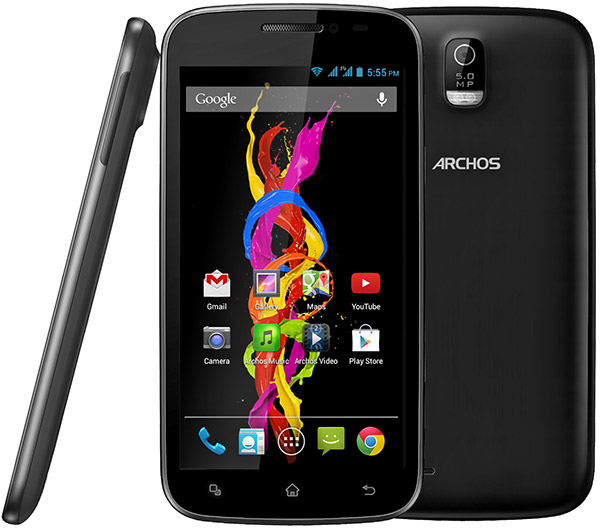
Overview of Archos 50 Titanium
The Archos 50 Titanium, released in 2013, is a smartphone that attempted to bring affordable technology to the masses with its balanced features. Although discontinued, this device still holds relevance for those interested in early Android technology and budget-friendly smartphones of its time.
Design and Build
This smartphone measures 144.5 x 73.7 x 9.9 mm and weighs 160 grams, making it quite standard for smartphones in its era. The design supports Dual SIM (Mini-SIM & Micro-SIM) capability, providing flexibility for users needing separate lines for work and personal use.
Display
The 5.0-inch IPS LCD screen with a resolution of 540 x 960 pixels provides decent quality viewing for its time. The display’s pixel density of ~220 ppi, while not the sharpest, offers satisfactory clarity for everyday tasks such as browsing and reading. The screen-to-body ratio stands at approximately 64.7%, ensuring a modern feel despite its age.
Performance
Powered by a Mediatek MT6572 chipset and a Dual-core 1.3 GHz Cortex-A7 CPU, the Archos 50 Titanium delivers basic performance suitable for light multitasking and everyday applications. The Mali-400 GPU supports light gaming, although it may not handle more demanding graphics-intensive games. With its 512MB RAM, the device might struggle with modern applications but serves basic functions well.
Operating System
Running Android 4.2.2 (Jelly Bean), the Archos 50 Titanium features an interface that, while dated, was quite popular in its time for its user-friendliness and efficiency. Users can access a wide array of applications available from the Google Play Store, even though some newer applications may not support this older version.
Storage
The internal storage of 4GB, combined with the 512MB RAM, could be considered limited by today’s standards. However, the inclusion of a dedicated microSDHC slot allows users to expand the storage, providing flexibility for storing photos, music, and other media.
Camera Capabilities
The Archos 50 Titanium is equipped with a single 5 MP rear camera featuring autofocus and LED flash, delivering basic photography needs. It supports video recording at 720p, suitable for capturing moments without the expectation of high-definition quality. The front VGA camera offers basic video-calling capabilities, catering to minimalistic selfie needs.
Battery Life
The device features a removable Li-Ion 2100 mAh battery, which can sustain moderate use throughout a day. Given its low-demand hardware and software, the battery life, while average, suffices for users not engaging in excessive multimedia consumption or gaming.
Connectivity Options
Connectivity-wise, the phone supports GSM and HSPA networks, offering reasonable mobile network speeds of up to HSPA 21.1/5.76 Mbps. It includes Wi-Fi 802.11 b/g/n, Bluetooth 2.1 with A2DP and EDR, and GPS. Lacking NFC, the device nonetheless offers a stereo FM radio and microUSB 2.0 for data transfer.
Multimedia
The Archos 50 Titanium includes a loudspeaker and a 3.5mm audio jack, ensuring compatibility with headphones and auxiliary audio connections. The presence of a stereo FM radio caters to users who enjoy traditional broadcasting without internet usage.
Additional Features
The device includes basic sensors such as an accelerometer, which enhances the user experience by automatically adjusting the display orientation. While it lacks some modern sensors, its features were more than adequate for standard functionality upon its release.
Conclusion
Overall, the Archos 50 Titanium represented a cost-effective solution, providing essential smartphone capabilities without extra frills. Its presence in the market contributed to making smartphones more accessible to a broader audience, setting a precedent for the development of budget-friendly mobile devices. While discontinued and largely outpaced by newer technology, it remains a part of the evolution of smartphone design and accessibility.
Key Features of Archos 50 Titanium
- Supports Dual SIM functionality (Mini-SIM & Micro-SIM).
- Equipped with a 5.0-inch IPS LCD display for better viewing angles and color accuracy.
- Powered by a Dual-core 1.3 GHz Cortex-A7 processor for basic performance needs.
- Includes a 5 MP main camera with autofocus and LED flash for basic photography.
- Offers expandable storage via microSDHC slot to increase storage capacity.
- Comes with Wi-Fi capabilities including hotspot and DLNA support.
- Features GPS support for location-based services.
- Includes a removable Li-Ion 2100 mAh battery for easy replacement.
- Traditional 3.5mm headphone jack for audio connectivity.
Disadvantages of Archos 50 Titanium
- Discontinued status, making it difficult to find and support.
- Low screen resolution of 540 x 960 pixels, resulting in ~220 ppi density, which may not provide sharp display quality.
- Outdated Android 4.2.2 (Jelly Bean) operating system, lacking modern features and security updates.
- Limited internal storage of 4GB, constraining app installations and storage of media.
- Low RAM of 512MB, which could lead to performance issues and slow multitasking.
- Mediocre camera quality with only a 5 MP main camera and VGA selfie camera.
- Older Bluetooth version 2.1, which may not support connecting to newer devices smoothly.
- Absence of NFC, limiting contactless payment and data sharing capabilities.
- Limited sensor availability, only featuring an accelerometer.
- Removable battery with only 2100 mAh, which might not provide long-lasting power for modern app usage.

View Also
More Phones
All Rights Reserved +14266 Phones © Mobilawy 2025

























